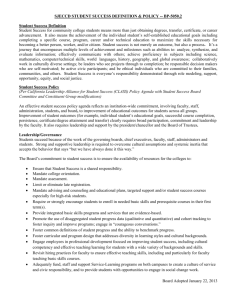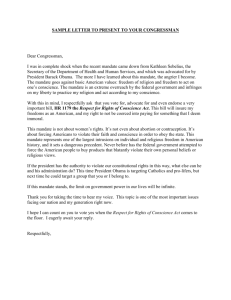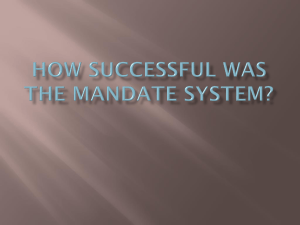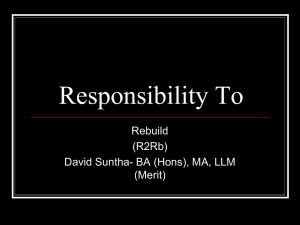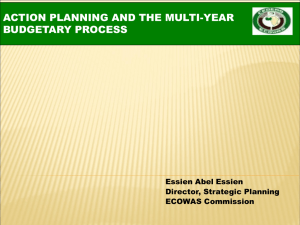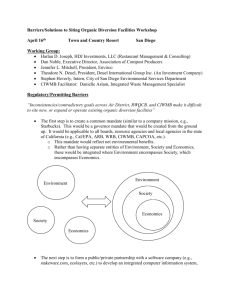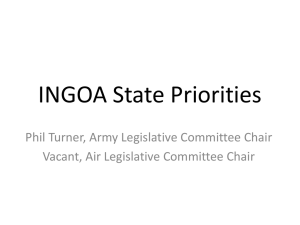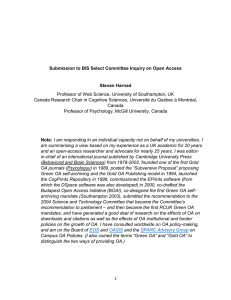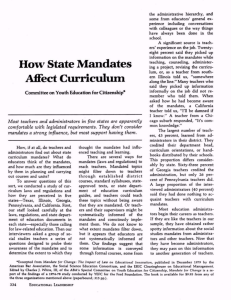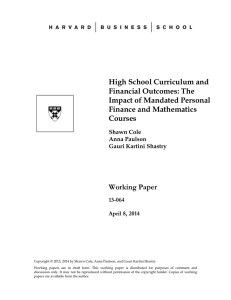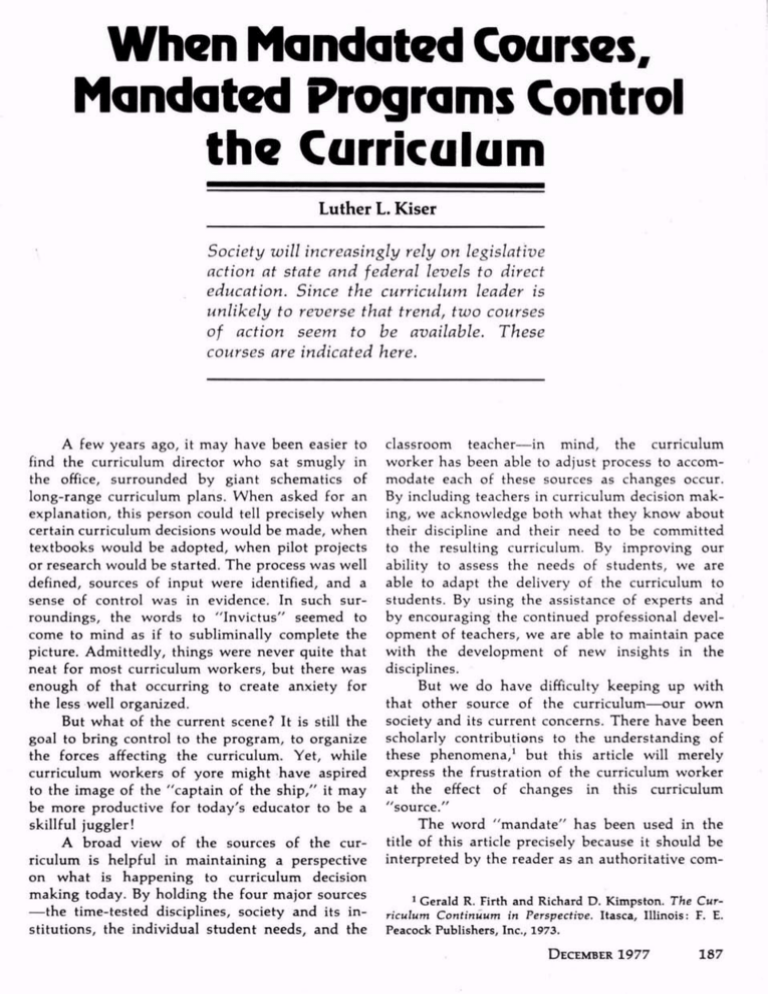
When Mandated Courses,
Mandated Programs Control
the Curriculum
Luther L. Riser
Society will increasingly rely on legislative
action at state and federal levels to direct
education. Since the curriculum leader is
unlikely to reverse that trend, two courses
of action seem to be available. These
courses are indicated here.
A few years ago, it may have been easier to
find the curriculum director who sat smugly in
the office, surrounded by giant schematics of
long-range curriculum plans. When asked for an
explanation, this person could tell precisely when
certain curriculum decisions would be made, when
textbooks would be adopted, when pilot projects
or research would be started. The process was well
defined, sources of input were identified, and a
sense of control was in evidence. In such sur
roundings, the words to "Invictus" seemed to
come to mind as if to subliminally complete the
picture. Admittedly, things were never quite that
neat for most curriculum workers, but there was
enough of that occurring to create anxiety for
the less well organized.
But what of the current scene? It is still the
goal to bring control to the program, to organize
the forces affecting the curriculum. Yet, while
curriculum workers of yore might have aspired
to the image of the "captain of the ship," it may
be more productive for today's educator to be a
skillful juggler!
A broad view of the sources of the cur
riculum is helpful in maintaining a perspective
on what is happening to curriculum decision
making today. By holding the four major sources
—the time-tested disciplines, society and its in
stitutions, the individual student needs, and the
classroom teacher—in mind, the curriculum
worker has been able to adjust process to accom
modate each of these sources as changes occur.
By including teachers in curriculum decision mak
ing, we acknowledge both what they know about
their discipline and their need to be committed
to the resulting curriculum. By improving our
ability to assess the needs of students, we are
able to adapt the delivery of the curriculum to
students. By using the assistance of experts and
by encouraging the continued professional devel
opment of teachers, we are able to maintain pace
with the development of new insights in the
disciplines.
But we do have difficulty keeping up with
that other source of the curriculum—our own
society and its current concerns. There have been
scholarly contributions to the understanding of
these phenomena, 1 but this article will merely
express the frustration of the curriculum worker
at the effect of changes in this curriculum
"source."
The word "mandate" has been used in the
title of this article precisely because it should be
interpreted by the reader as an authoritative com1 Gerald R. Firth and Richard D. Kimpston. The Cur
riculum Continuum in Perspective. Itasca, Illinois: F. E.
Peacock Publishers, Inc., 1973.
DECEMBER 1977
187
mand. Th« greater society expresses its authori
tative commands through state and federal legis
lation. That must mean, then, that the universallyheld beliefs on the direction of our society are
to be found in the laws on education in the
various states and in those emanating from Wash
ington. Not so, for legislation is accomplished
through the political process, through compro
mise, through an accommodation of differences
in opinion. It is very seldom that the resulting
"mandate" is a universally-held value in the local
community school district where the actual imple
mentation must occur.
Quandaries
1. Career education can be looked upon in
one community as an antiacademic move, while
in another it will be accused of blunting the
sharp vocational focus of the schools. The man
date is the same, but not the application. And
where does career education fit in the structure
of curriculum committees organized around the
"time-tested disciplines?" Oh, multi-discipline?
Fine, under whose leadership? Completely re
structure, you say? You mean that teachers will
be completely reprogrammed to focus on this
concern, and departmental lines at the university
will be removed so that new teachers coming to
us will be prepared in this manner? Many ele
mentary and secondary schools reacted quickly to
the mandate with some belief that it did meet a
need. But the massive superstructure of educa
tion has not moved to alter teacher preparation
programs or other curriculum expectations.
2. Title IX became the vehicle for express
ing the mandate relative to our society's concern
for reducing sexism, sex-role stereotyping, and
for providing true equality regardless of sex.
This is the strongest federal mandate of recent
years, but even U.S.O.E. had great difficulty in
developing the guidelines, and when this mandate
is applied in the local school system the lack of
universal interest in the topic is evident, as is the
realization of the need for broadening the cur
riculum decision-making structures.
But the matter is even more complicated
than that. The application of the equal oppor
tunity concept is not exclusively a male/female
concern. Black members of our society have been
188
EDUCATIONAL LEADERSHIP
at this a long time, and other ethnic groups are
demanding attention. Sure, we have had civil
rights legislation and affirmative action programs,
but cannot all this be accommodated in some
organized, coherent manner? The Department of
Public Instruction in Iowa said "yes" to this ques
tion and developed guidelines for a multicultural,
nonsexist curriculum. While this now appears to
be a well coordinated approach to this concern,
the series of mandates leading to this point was
not so neat and clean.
In 1974, the Iowa legislature passed a school
bill that had this mandate for the "social studies"
curriculum at elementary, junior high, and senior
high:
. . . with attention given to the role in history
played by all persons, and a positive effort shall be
made to reflect the achievements of women, minori
ties, and any others who, in the past, may have been
ignored or overlooked by reason of race, sex, religion,
physical disability, or ethnic background.
Thus, elementary teachers and secondary
teachers of social studies became involved in
sensitization efforts, in materials search and de
velopment, and in general program development.
During the school year 1975/76, a state
advisory committee developed G uidelines for a
Multicultural, Non-Sexist Curriculum in Iowa.
Discussions of this committee led to a State Board
of Public Instruction mandate that educators
corning into the field by 1980 and those request
ing certificate renewals after that time complete
forty-five hours of human relations training.
Guidelines from DPI Committee on Certification
Standards provided for both local and universitybased programs to meet this requirement.
The 1976/77 legislative session saw the
aforementioned section removed from the three
social studies curriculum sections, and the fol
lowing statement was added to Section 1 of the
School Code, thereby becoming a precursor for
all education efforts:
Where applicable, the education program shall
be taught with attention given to all persons who
have made significant contributions to a given area
of study, and a positive effort shall be made to reflect
the achievements of women, minorities, and any
other persons, organizations or groups of persons who,
in the past, may have been overlooked by reason of
race, sex, religion, physical disability, occupation, or
ethnic background.
Hence, in three years, schools received three
different sets of directives, all focused on the
same problem, each with a slightly different focus.
Is it any wonder that most educators breathe a
sigh of relief when the legislators finally retire
for the season? The most recent and compre
hensive revision of laws pertaining to school pro
grams in Iowa in 1974 had sixteen new sections
. . . this in a bill with only eighteen sections!
3. Probably no other curriculum/instruc
tional concern has come in for more change
through state and federal legislation in recent
years than special education. The mandates here
have required an effort to educate all youth, re
gardless of handicapping condition, and to do
it in the "least restrictive environment." This has
forced general educators and special educators to
collaborate and cooperate as never before. Cer
tainly, all educators are facing the mandate of
Public Law 94-142, The All Handicapped Chil
dren Act, but many states have legislative man
dates predating that federal action. The federal
regulations obviously differ from what each state
is currently doing despite a common goal. An
other effort will have to be made to accommo
date the new definitions and program require
ments.
The Iowa plan for special education was
imbedded in legislation establishing sixteen area
education agencies. These AEA's were given full
responsibility for implementing the special educa
tion requirements, hence mandating a completely
new level of bureaucracy with its attendant in
crease in human interactions. At least in Iowa,
this was accompanied with significant increases
in the foundation finance formula through the
use of a weighted enrollment factor. Reports
from other parts of the country seem to indicate
that legislators don't always provide increased
funds for increased services!
4. The lag between legislative mandates and
the publication of guidelines or regulations from
the appropriate education agency is a problem of
process for the local curriculum leader. Interested
people read about legislative action, interpret its
application in the local community to their own
satisfaction, and demand immediate action.
The following is taken from the first part
of a memo written by the author to a group of
principals regarding a meeting on the new Fed
eral Education Bill held at Drake University on
September 7, 1974:
The Legislative Officer for the U.S. Office of Ed
ucation and the Counsel for the Senate Labor and
Public Welfare Committee (Education) spent a great
deal of time at this meeting attempting to give us an
overview of this most recent education legislation.
This memo will attempt to summarize some of that
information.
It should be noted that despite the action of the
legislators and the President, much of what is in
volved will not be operative for some time. We were
reminded that the U.S.O.E. has sixty days to submit
plans for developing regulations and guidelines for
this legislation. Within that time the plan must be
submitted to the legislative branch for approval. The
U.S.O.E. then has ISO days in which to actually de
velop the regulations and guidelines. Following that,
Congress has forty-five days to review and approve
said regulations and guidelines. You should have fig
ured out by now that we will probably receive the
regulations next school year.
There followed three pages of changes and
additions that would be affecting our schools,
but it would take considerable time before we
could even begin operating under the mandate.
If the curriculum leader is truly attuned to
society as a source of the curriculum, that person
may be able to move program development along
smoothly in areas of major concern without giv
ing the impression of hopscotching around the
currently fashionable topics and without a series
of false starts.
How, in fact, are these mandates controlling
our schools? By making the curriculum worker's
task more difficult? by creating confusion relative
to the specific paths to follow? While there is an
aspect of truth in the last two questions, these
are merely controlling factors that tend to drain
off energy that might be more productively spent.
No, the effect is much more important than the
inconvenience created for some curriculum lead
ers. We find, in a report of some recent research
on "Responsiveness of Schools to Their Clien
tele" headed by Dr. Harmon Zeigler, a series of
succinct statements that provide a view of shift
ing federal demands on schools:
The major problem of educational planners in
the early 1900s, Zeigler points out, was to "homoge
nize" an immigrant population, infuse it with a con
sistent set of values, and reduce conflict—in short, to
"manufacture a cohesive society." The goal was staDECEMBER 1977
189
bility, not social change; and schools as transmitters
of knowledge, culture, and social norms became con
servative in their role of maintaining the social order.
But beginning with the Supreme Court decision
in the Brown case in 1954 and continuing with the
Elementary and Secondary Education Act of 1965,
that situation was almost wholly reversed. The Fed
eral government decided to use schools as instru
ments to achieve social and economic equality, "a
transformation of the primary goal of public educa
tion."
By becoming the spokesman for the underpriv
ileged, the Federal government was responding to de
mands which local schools could not meet, Zeigler
says. . . . Hence the Federal government, the tradi
tional defender of the downtrodden against the con
servatism of local community power structures, took
the role of advocacy for the underdog.
The B rown decision and subsequent Federally
mandated desegregation "shifted the arena of con
flict and decision from local to national govern
ment. . . ." Further, the Elementary and Secondary
Education Act, with its influx of Federal funds,
"created a new pattern of interaction which made the
notion of lay control through school boards obso
lete." 2
The true focus of this project, conducted
through the University of Oregon's Center for
Educational Policy and Management, was the
concern over the eroded power of local school
boards and administrators, and this is manifest
in many areas outside the actual school curricu
lum. But the point to be made here is that these
federal mandates, to a greater extent all the time,
are prescribing the local curriculum.
What is the overall effect of the various
mandates that have been discussed here? In every
case, the mandate indicates what schools should
do, what should be taught, or in what manner
something should be taught. In no instance does
it say, "Accomplish this mandate by reducing or
eliminating your efforts in some other, more tra
ditional area." So the requirements of the cur
riculum change, and the classroom teacher loses
a bit of autonomy for curriculum choice. Oh, the
choice is there, but it now relates to how well
the traditional curriculum can be compacted in
order to add the new requirement.
We prepare teachers with a strong back
ground in their discipline, recognize that as a
source of the curriculum, and then expect them
to make choices to reduce the content their disci
pline has valued in order to accommodate new
demands from state or national level mandates.
190
EDUCATIONAL LEADERSHIP
So, the mandate gets added in some fashion, but
probably not at the expense of dropping some
thing else. Is it any wonder that the most uni
versal theme heard in teachers' complaints is the
need for more "time to teach"? And who do the
teachers perceive as pushing these "unreasonable"
demands on them? Legislators and special interest
groups are too far removed to feel the frustra
tion of teachers, but the principal or the cur
riculum director or other curriculum leaders are
not.
Many mandates are not so much concerned
with new content for the curriculum as they are
the process of education. Now, however, when
the concern is the "delivery" of the curriculum,
the time involvement is not one of accommodat
ing new content but the crowding of the teacher's
time through in-service courses or other staff
development efforts. The response is the same—
a natural human reticence to change, to give the
time, to make the effort.
In conclusion the trend would lead us to
believe that society will increasingly rely on legis
lative action at the state and federal level to
direct the institution of public education. The
curriculum leader is not likely to reverse that
trend, so at least two avenues lie open, both of
which must be traveled.
First, the curriculum leader is challenged to
make the need for change so essential and so
personal that inertia is overcome and the teacher
as a "source of the curriculum" is accommodated
along with the "mandate."
Second, curriculum leaders must become so
well organized and so politically aware that they
have some effect on the content of legislative
mandates before such action is taken. [K
2 Report on Education Research. Washington, D.C.:
Capitol Publications, June 1, 1977. p. 9.
Luther L. Kiser is the
Assistant Superintend
ent for Curriculum and
Instruction of the Ames
Community School Dis
trict, Ames, Iowa,
Copyright © 1977 by the Association for Supervision and Curriculum
Development. All rights reserved.

